Wed Apr 27, 5:34 pm ET
By Rachel Rose Hartman
news.yahoo.com/
During the 2008 campaign, questions about John McCain's birth in the Panama Canal Zone on a U.S. military base prompted some to ask whether McCain was eligible to be president, since the Constitution stipulates that anyone not born in the United States is not eligible to be president.
Amid a flurry of news reports, McCain's own campaign announced in February 2008 that it was conducting an investigation. When a bipartisan pair of lawyers announced the following month that McCain was indeed eligible, the issue virtually died--apart from a Senate resolution that pretty much laid the question to rest by attesting to the facts surrounding McCain's birth and citizenship.
But the winner of the 2008 election, Barack Obama, has faced a relentless campaign questioning his U.S. citizenship--and thereby the legitimacy of his presidency--that has disregarded the facts.
Questions regarding Obama's birth certificate have persisted for more than two years, as the president noted Wednesday at a press conference announcing the release of his long-form birth certificate. A vast array of evidence attests to Obama's citizenship--including a certificate of live birth, signed affidavits from people who viewed Obama's long-form birth certificate, confirmation by Hawaiian officials, and independent investigations by news outlets. Nevertheless, "this thing just keeps going" as Obama said this morning. Even after the White House released the long-form certificate of Obama's birth, birther leader Orly Taitz—who has filed unsuccessful lawsuits seeking to obtain access to Obama's birth certificate—sought to cast doubt on the document's authenticity, suggesting that in 1961, Hawaiian officials would have classified Obama as "Negro" rather than using designation "African," which suggests, in her view, a more contemporary concern for "political correctness."
So what's fueling the dogged questioning of Obama's origins? Many critics of the birther movement say its core tenets--and its stubborn resistance to evidence disproving those beliefs--can be traced to racial hostilities. The fundamental birtherist conviction, these critics say, is that an African-American can't have legitimately won the presidency--and that his elevation to power therefore has to be the result of an elaborate subterfuge.
"There is a real deep-seated and vicious racism at work here in terms of trying to de-legitimate the president," Peniel Joseph, a professor of history at Tufts University, told The Ticket.
"This is more than just a conspiracy," Peniel added. "I think this is fundamentally connected to white supremacism in this country."
Miami Herald columnist Leonard Pitts Jr. in early April called for the connection to be publicly drawn between birthers and racism: "So it is time to call this birther nonsense what it is--not just claptrap, but profoundly racist claptrap."
And columnist Michael Tomasky wrote for The Guardian Wednesday that the birther conspiracy "had to be the only explanation for how this black man got to the White House." He added: "And if you think race isn't what this is about at its core, ask yourself if there would even be a birther conspiracy if Barack Obama were white and named Bart Oberstar. If you think there would be, you are delusional."
In a similar vein, Rev. Jesse Jackson told Politico yesterday that Donald Trump's campaign to get Obama to release his birth certificate is deeply rooted in race.
"Any discussion of [Obama's] birthplace is a code word," Jackson said. "It calls upon ancient racial fears." Jackson later added that, in his view, Trump "is now tapping into code-word fears that go far beyond a rational discourse."
Birthers emphatically deny such criticism. But it's difficult to apprehend the ongoing resistance to proof of Obama's citizenship without crediting racial fear as a significant factor. At first, after all, many adherents of birtherism argued that the administration fueled speculation by failing to release the long-form version of Obama's birth certificate, but now that this version has been released to the public, the call continues to go out for other kinds of information about Obama's past to be released--a level of scrutiny that neither McCain nor Obama's 43 predecessors in the Oval Office were expected to face.
Trump, who has railed against Obama as he floats himself as a presidential contender, on Wednesday at a press conference in New Hampshire called for Obama to release his academic transcripts:
The word is, according to what I've read, that he was a terrible student when he went to Occidental. He then gets to Columbia. He then gets to Harvard. I heard at Columbia he wasn't a very good student. He then gets to Harvard. How do you get into Harvard if you're not a good student. Maybe that's right or maybe that's wrong. But I don't know why he doesn't release his records. Why doesn't he release his Occidental records?
Trump and others have accused Obama of not authoring his memoir, while many Obama detractors continue to argue he is secretly Muslim. Both Jackson and Peniel noted that never before has a sitting president's nationality been questioned.
Meanwhile, an eye-opening recent study from the University of Delaware appears to confirm that race-minded detractors of Obama view him as "less American"--as Dan Vergano writes for USA Today.
The study, which surveyed blacks and whites on their opinions of Obama compared to Vice President Joe Biden, found that whites classified as "higher prejudice-predicted Whites" viewed Obama as "less American"--a view that, in turn, resulted in lower evaluations of the president's performance.
"Finally, many in the media have speculated that current criticisms of Obama are a result of his race, rather than his agenda. We believe that the current results are an empirical demonstration that this is sadly the case," the study concluded in its analysis. "As the United States approaches important decisions regarding issues such as economic reform, health care, and overseas military interventions, the intrusion of racial attitudes in the evaluation of political leaders' performance is ironically inconsistent with what many believe to be 'American.' "
Two separate national polls conducted this spring found that about half of Republicans don't believe Obama was born in the United States.
But Democrats and Republicans alike say that "birther" talk will be a political liability for whoever propagates the discussion.
"I don't think it's an issue that moves voters," Republican National Committee chairman Reince Priebus told reporters Tuesday. "It's an issue in my opinion that I don't personally get too excited about, because I think the more important question is what's going on in this country in regards to jobs, to debt, and the deficit and spending. Those are the things that people are worried about. People aren't worried about these other issues."
(Photo of Obama: J. Scott Applewhite/AP)
Thursday, April 28, 2011
Wednesday, April 27, 2011
11 things that are strangely inspiring by FHM
www.fhm.com/
Posted by Chris Mandle, 23 March 2011
11/ Goal of the month on Match Of The Day
The six minutes of the month when the Premiership ceases to be about knuckle-headed bigotry, a masochistic devotion to doomed causes and a level of money-grabbing gamesmanship that would shame Mohammed al-Fayed. As soon as GOTM fires up, it’s like being an excitable eight-year-old at your first match all over again. Stick some vaguely anthemic indie music over the top and you’re welling up.
10/ A three-legged cat pursuing an able-bodied cat
Mr Boots hasn’t been quite the same since those weird blokes set their dog on him and filmed it on their phones. But it’s not going to stop him protecting his turf. The plucky little bastard’s an example to us all (especially his owner, who turns off the lights and hides upstairs every Halloween in case ‘those kids from the estate’ come knocking).
9/ Helping a woman on some stairs with a pushchair
You, oozing alpha-male ‘protector’ musk, doing your bit to remind this fallen woman that chivalry still exists, that M People song about ‘What have you done today to make you feel proud’ playing on your internal jukebox. A bit of light hearted flirting with mum to make her feel ‘all woman’ again…You’re like Nigel Havers, if Nigel Havers had just sweated a whopping great Rorschach blot through the back of his suit and was having trouble standing up straight now.
8/ Comic Relief films about C-list celebs going to Africa
George Lamb looking a bit dumbstruck next to a bony cow. Denise Van Outen welling up in a malaria clinic. Gary Barlow doing a traditional dance in a grass skirt while Take That’s Greatest Day swells up in the background… and it’s not a coincidence that they re-run these just as you’re getting in from the pub and feeling guilty.
7/ An old bloke in a proper suit and tie
Especially when it’s 6am and you’re waddling home after a big night out and he’s made all that effort even though he’s just going out to get a newspaper and a pint of milk. It’s evidence of real moral fibre and the spirit that made this country great. Not evidence of, say, being paralysed by grief since the death of his wife, racked by insomnia and desperate for someone to talk to. No, don’t say it’s that.
6/ Training montage scenes from otherwise abysmal martial arts films
Obviously, the famous ones – Rocky, The Karate Kid – are among cinema’s greatest moments. But even the risible ones – No Retreat, No Surrender – are weirdly uplifting. And if you’re alone in the house, will lead to at least five minutes of attempting to do a fingertip push up and roundhouse the dog while listening to pumping synth rock.
5/ Queen’s The Show Must Go On
Forget Don’t Stop Me Now – this was Freddie’s real masterpiece. We like to think that if we were on the verge of keeling over from Aids we’d have the balls to give the grim reaper a defiant two fingers of this theatrical magnitude. We like to think that, but obviously the reality would involve pints of black market morphine, uncontrollable sobbing and several bet-hedging deathbed conversions to any religion that’d take us.
4/ Really Fat People At The Gym
Treadmill set to 2mph, steam billowing off them like a racehorse, towel wedged round their neck like a fluffy collar, XXXXXL Help For Heroes promotional T-shirt soaked through already. Risking a heart attack, public mockery and an hour of pounding chart house just to get up there. Good for you, tubby. Just don’t even think about coming in the sauna afterwards, okay?
3/ The London Marathon, c.7pm
All the losers waddling over the finish line in the London Marathon, dressed as one half of a rhinoceros, three hours after the Kenyans finished, got their medals, and touched down back home at Jomo Kenyatta Airport in Nairobi. An absolute triumph of dedication over athletic ability, cardio-vascular fitness, or logic.
2/ Waking up without a hangover
Of all the benefits – not having a headache, being able to touch your lower back without wincing, not smelling like George Best’s corpse etc – it’s the overwhelming sense of productivity which is so mindblowing when you’ve been off the sauce for a few days. If you stayed off it permanently you could probably run for government, learn Japanese… hell, maybe even hold a relationship down.
1/ The implosion of Gordon Ramsay’s life and business
If only because it makes you think that all those lessons you learned as a child – about manners getting you a long way, bullies never prospering and bullshitters getting found out – might actually be true.
-
Posted by Chris Mandle, 23 March 2011
11/ Goal of the month on Match Of The Day
The six minutes of the month when the Premiership ceases to be about knuckle-headed bigotry, a masochistic devotion to doomed causes and a level of money-grabbing gamesmanship that would shame Mohammed al-Fayed. As soon as GOTM fires up, it’s like being an excitable eight-year-old at your first match all over again. Stick some vaguely anthemic indie music over the top and you’re welling up.
10/ A three-legged cat pursuing an able-bodied cat
Mr Boots hasn’t been quite the same since those weird blokes set their dog on him and filmed it on their phones. But it’s not going to stop him protecting his turf. The plucky little bastard’s an example to us all (especially his owner, who turns off the lights and hides upstairs every Halloween in case ‘those kids from the estate’ come knocking).
9/ Helping a woman on some stairs with a pushchair
You, oozing alpha-male ‘protector’ musk, doing your bit to remind this fallen woman that chivalry still exists, that M People song about ‘What have you done today to make you feel proud’ playing on your internal jukebox. A bit of light hearted flirting with mum to make her feel ‘all woman’ again…You’re like Nigel Havers, if Nigel Havers had just sweated a whopping great Rorschach blot through the back of his suit and was having trouble standing up straight now.
8/ Comic Relief films about C-list celebs going to Africa
George Lamb looking a bit dumbstruck next to a bony cow. Denise Van Outen welling up in a malaria clinic. Gary Barlow doing a traditional dance in a grass skirt while Take That’s Greatest Day swells up in the background… and it’s not a coincidence that they re-run these just as you’re getting in from the pub and feeling guilty.
7/ An old bloke in a proper suit and tie
Especially when it’s 6am and you’re waddling home after a big night out and he’s made all that effort even though he’s just going out to get a newspaper and a pint of milk. It’s evidence of real moral fibre and the spirit that made this country great. Not evidence of, say, being paralysed by grief since the death of his wife, racked by insomnia and desperate for someone to talk to. No, don’t say it’s that.
6/ Training montage scenes from otherwise abysmal martial arts films
Obviously, the famous ones – Rocky, The Karate Kid – are among cinema’s greatest moments. But even the risible ones – No Retreat, No Surrender – are weirdly uplifting. And if you’re alone in the house, will lead to at least five minutes of attempting to do a fingertip push up and roundhouse the dog while listening to pumping synth rock.
5/ Queen’s The Show Must Go On
Forget Don’t Stop Me Now – this was Freddie’s real masterpiece. We like to think that if we were on the verge of keeling over from Aids we’d have the balls to give the grim reaper a defiant two fingers of this theatrical magnitude. We like to think that, but obviously the reality would involve pints of black market morphine, uncontrollable sobbing and several bet-hedging deathbed conversions to any religion that’d take us.
4/ Really Fat People At The Gym
Treadmill set to 2mph, steam billowing off them like a racehorse, towel wedged round their neck like a fluffy collar, XXXXXL Help For Heroes promotional T-shirt soaked through already. Risking a heart attack, public mockery and an hour of pounding chart house just to get up there. Good for you, tubby. Just don’t even think about coming in the sauna afterwards, okay?
3/ The London Marathon, c.7pm
All the losers waddling over the finish line in the London Marathon, dressed as one half of a rhinoceros, three hours after the Kenyans finished, got their medals, and touched down back home at Jomo Kenyatta Airport in Nairobi. An absolute triumph of dedication over athletic ability, cardio-vascular fitness, or logic.
2/ Waking up without a hangover
Of all the benefits – not having a headache, being able to touch your lower back without wincing, not smelling like George Best’s corpse etc – it’s the overwhelming sense of productivity which is so mindblowing when you’ve been off the sauce for a few days. If you stayed off it permanently you could probably run for government, learn Japanese… hell, maybe even hold a relationship down.
1/ The implosion of Gordon Ramsay’s life and business
If only because it makes you think that all those lessons you learned as a child – about manners getting you a long way, bullies never prospering and bullshitters getting found out – might actually be true.
-
Labels:
Fun,
Jokes,
Media,
Motivation
Saturday, April 23, 2011
Earth Day: Conservationist or Communist? Behind Google's Doodle
Separating the real from the rumored on the ultimate green day.

Named for late novelist and philosopher Ayn Rand, the institute promotes the "principles of reason, rational self-interest, individual rights, and laissez-faire capitalism to the widest possible audience," according to its Web site.
Much as libertarian groups oppose late March's Earth Hour, the Ayn Rand Institute opposes Earth Day as a celebration of the anti-capitalist environmental movement, Lockitch said.
"Whenever there is a conflict between protecting nature from any kind of human activity versus pursuing some human value, environmentalists will consistently side with nature," he said.
For example, he said, environmentalists protest the construction of hydroelectric dams because they might affect species' habitat—even though industrial society needs electricity to survive.

A diver prepares to transplant a young coral in Indonesia during last year's Earth Day observations.
Updated April 22, 2011
Though Earth Day still has its detractors, organizers expect more than a billion people to observe Earth Day today—a far cry from the movement's grassroots beginnings in 1970.
Another big difference from the first Earth Day: Many will mark the day digitally in 2011—thanks in no small part to today's Google Doodle, which publicizes Earth Day with an impossible animated Eden where pandas, penguins, and lions live in peace and an iceberg is just a pounce away from an African savanna.
And just this past Tuesday, the Washington, D.C.-based Earth Day Network—founded by the organizers of the first Earth Day—launched a new Facebook Web app to promote their Billion Acts of Green campaign. The project aims to generate a billion pledges of environmental service and advocacy before the Rio+20 Earth summit in Brazil from June 4 to 6, 2012.
"This is really about moving people beyond environmental education and getting everybody to commit to at least one thing—as evidence, we hope, to the world governments that one in seven people on the planet has taken an action," said Kathleen Rogers, president of Earth Day Network.
To date, the campaign is more than a tenth of the way to its goal. Acts pledged range from the Taiwan-based Hima Foundation's effort to plant a million trees to more personal promises, such as one participant's promise to "never leave my laptop ON when I'm not using it."
According to Rogers, the online pledges are helping to build a social network of, and a sounding board for, conservationists who want their voices heard.
"People want to be counted," she said. "They are frustrated that their governments haven't done anything, including our own," she said, referring to the U.S. government.
Why Is April 22 Earth Day?
Every day, the saying goes, is Earth Day. But it's popularly celebrated on April 22. Why?
One persistent rumor holds that April 22 was chosen because it's the birthday of Vladimir Lenin, the founder of the Soviet Union.
"Lenin's goal was to destroy private property and this goal is obviously shared by environmentalists," according to a 2004 Capitalism Magazine article perpetuating the theory.
Likewise, shortly after the first Earth Day, a Daughters of the American Revolution member lamented to Time magazine, "Subversive elements plan to make American children live in an environment that is good for them."
The Earth Day Network's Rogers, though, scoffed at the rumored communist connection.
April 22, 1970, was chosen for the first Earth Day in part because it fell on a spring Wednesday—ideal for encouraging a large turnout, especially of college students, for an environmental event held across the United States, Rogers said.
"It worked out perfectly, because everybody was at work and they all left," she said.
In fact, more than 20 million people across the U.S. were estimated to have participated in that first Earth Day. (Pictures: "The First Earth Day—Bell-Bottoms and Gas Masks.")
More than a billion people in 180 countries around the world now celebrate Earth Day every year, Rogers said.
Roots of Earth Day
Earth Day's history is rooted in the 1960s, when the environment was in visible ruins and people were angry, according to Rogers.
"It wasn't uncommon in some cities during rush hour to be standing on a street corner and not be able to see across the street" because of pollution, she said.
Despite the anger, green issues were absent from the U.S. political agenda. This frustrated U.S. Senator Gaylord Nelson of Wisconsin, whose campaigns for the environment through much of the 1960s had fallen flat.
In 1969 Nelson hit on the idea of an environmental protest modeled after anti-Vietnam War demonstrations called teach-ins.
"It took off like gangbusters. Telegrams, letters, and telephone inquiries poured in from all across the country," Nelson recounted in an essay shortly before he died in July 2005 at 89.
"The American people finally had a forum to express its concern about what was happening to the land, rivers, lakes, and air—and they did so with spectacular exuberance." (See pictures of quirky Earth Day stunts.)
Nelson recruited activist Denis Hayes to organize the April 22, 1970, Earth Day teach-in, which today is sometimes credited for launching the modern environmental movement.
By the end of 1970, the U.S. Environmental Protection Agency had been born, and efforts to improve air and water quality were gaining political traction.
"It was truly amazing what happened," Earth Day Network's Rogers said. "Blocks just tumbled."
(Related: Earth Day kids cartoons.)
Earth Day Evolves
Amy Cassara, a senior associate at the World Resources Institute in Washington, D.C., analyzes global environmental trends.
She noted that, since the first Earth Day, environmentalism has moved from a fringe issue to a mainstream concern. "As many as 80 percent of Americans describe themselves as environmentalists," Cassara said. (Learn how you can help this Earth Day.)
Environmental issues today, however, are less immediate than dirty air, toxic water, and a hole in the ozone layer, she added.
For example, the impacts of global warming are largely abstract and difficult to explain "without coming off as a doomsday prognosticator," Cassara said.
As the world becomes "more industrialized and our supply chains become less transparent, it can be more difficult to understand the environmental consequences of our actions," she said.
Earth Day Has Lasting Impact
Earth Day Network is pushing the Earth Day movement from single-day actions—such as park cleanups and tree-planting parties—to long-term commitments.
"Planting a tree, morally and poetically, requires taking care of it for a really long time, not just sticking it in the ground," Earth Day Network's Rogers said.
To help make the transition, the organization has engaged a hundred thousand schools around the world, integrating environmental themes into the year-round curriculum.
"They announce the results on Earth Day, so Earth Day becomes a moment in time," Rogers said.
The World Resources Institute's Cassara added that her organization uses Earth Day to convene with leaders in the movement and assess progress in their campaigns.
Now that it's so widely known, Earth Day "doesn't raise awareness among the general public in the same way that it used to. But it still provides a benchmark for reflection among those of us in the environmental community," she said.
What to Do on Earth Day?
Hundreds of events are held each year across the world on and around April 22 to mark Earth Day, Rogers said. (Related: "First Green Supersonic Jet Launches on Earth Day.")
The 122 Winslow Café outside Seattle, for example, is hosting an Earth Day Celebration with live music and awareness campaigns—including prizes for partygoers who arrive via pedal power.
In Tarijia, Bolivia, a mass planting of 10,000 trees is scheduled. And in Fiji divers will take part in Dive for Earth Day, which rallies thousands of people to don scuba gear to clean up and survey reefs.
And—in a move sure to add to those rumors of anti-capitalist intent—many corporations are literally giving products away. Among the heavily advertised Earth Day freebies are free coffee at Starbucks and Caribou Coffee, free reusable bags at Disney stores, and free trees at Lowe's home-improvement stores.
On the federal front, all U.S. national parks are free on Earth Day as part of National Park Week. (See readers' pictures of national parks.)
Anti-Earth Day
Don't expect to find Keith Lockitch, a fellow with the Ayn Rand Institute in Irvine, California, at any Earth Day rallies.
Named for late novelist and philosopher Ayn Rand, the institute promotes the "principles of reason, rational self-interest, individual rights, and laissez-faire capitalism to the widest possible audience," according to its Web site.
Much as libertarian groups oppose late March's Earth Hour, the Ayn Rand Institute opposes Earth Day as a celebration of the anti-capitalist environmental movement, Lockitch said.
"Whenever there is a conflict between protecting nature from any kind of human activity versus pursuing some human value, environmentalists will consistently side with nature," he said.
For example, he said, environmentalists protest the construction of hydroelectric dams because they might affect species' habitat—even though industrial society needs electricity to survive.
Instead of celebrating the environmental movement, Lockitch said, "we should have a Be Proud of Being Human Day … not a Feel Guilty for Trampling on Mother Earth Day."
-
-
Wednesday, April 20, 2011
Japanese customs worthy of emulation
Monday April 18, 2011
A SIP OF MATCHA thestar.com.my/lifestyle
By SARAH MORI
The honesty and integrity of the Japanese make them worthy role models.
A JAPANESE friend told me that her American acquaintance was amazed by the discipline of the Japanese while watching the news on the recent tsunami catastrophe on CNN. Railway systems were suddenly disrupted on March 11 and the roads were choked with vehicles and people.
“The people in Japan are so rule-orientated. Despite the fact that no vehicle could move, pedestrians duly stopped when the traffic signal at the crosswalk turned red. I would have just walked across,” she told my friend, over the phone.
Jishuku (voluntary self-restraint) is the keyword here. In deference to the tragedies, cherry blossom viewing parties this spring have been scaled down. Several festivals and night illuminations of cherry trees were scrapped at major viewing sites in a bid to conserve electricity.
Nevertheless, excessive jishuku may hurt Japan’s economy.

Orderliness is the norm. Commuters queue up for public transport. In the wake of the earthquake and tsunami, the old and young dutifully lined up for their supplies.
When queuing up at some stores, customers have to follow the arrow marks on the floor to the respective checkout counters. At a certain university hospital, mats with shoe marks are placed for people to wait in line when paying their medical bill.
A middle-aged woman once got riled up when the cashier declined to attend to her first. I was facing the entrance at the checkout counter, whereas the woman was facing me. She argued that she came before me as I was about to be attended to.
Although the cashier relented after I offered to let the woman pay first, she chided her for lining up in the wrong direction.
In the aftermath of the triple disasters, people around the world marvelled at the absence of mass looting. Thousands of personal possessions retrieved from the disaster areas are waiting to be claimed at municipal buildings.
To provide clues or help in the identification of missing or dead persons, some individuals who handed in the items attached notes indicating where they were found. Even if the owners were dead, their belongings would be of great sentimental value to surviving family members.
Rescue workers and residents have turned in tens of millions of yen in cash recovered from the ravaged areas of the Tohoku region to the police. Since the money could not be traced to the owners due to missing identification, the authorities are using it to help in the reconstruction of devastated areas.
One plausible reason for the absence of mass looting could be integrity. Generally, the Japanese find it unethical to take things that do not belong to them.
Politeness is another typical trait. Whenever customers enter a store, the staff greet them with irasshaimase (welcome). Near the till is a tray for customers to place their cash. The cashier counts the change twice in front of the customer, who is given a bow and a “thank you” when they leave.

Signboards near construction sites also reflect the courtesy of the Japanese.
Take, for example, the ongoing renovations of two playgrounds in my neighbourhood. A signboard on the hoarding depicts a character bowing next to a written apology. Another one illustrates an even more courteous character – holding his helmet at his side and bowing.
During the maintenance of the highway adjacent to my apartment block, an anime-like female character with an apologetic bow is limned on a signboard. The guard on duty greeted me and bowed as I walked past. I returned the greeting.
Yet, there is one habit which I find peculiar among most Japanese, regardless of gender. A long time ago, a worker called on me to apologise for the inconvenience caused by some road repairs. As he was explaining, my eyes were attentively following his middle finger pointing at the affected routes on a map on the flyer.
Don’t get me wrong. He wasn’t extending his middle finger uncouthly, for the rest of his fingers were only slightly curled in. This habit has become incognizant among many foreigners in Japan, including yours truly. But when showing direction or pointing to someone in a formal way, we extend our palm.
I’ve learnt that certain behaviours which may be accepted back home in Malaysia are indecorous here. And after a period of living in Japan, one tends to blend in with the Japanese way of life.
Sarah Mori, a Malaysian married to a Japanese, has been living in Japan since 1992.
-
A SIP OF MATCHA thestar.com.my/lifestyle
By SARAH MORI
The honesty and integrity of the Japanese make them worthy role models.
A JAPANESE friend told me that her American acquaintance was amazed by the discipline of the Japanese while watching the news on the recent tsunami catastrophe on CNN. Railway systems were suddenly disrupted on March 11 and the roads were choked with vehicles and people.
“The people in Japan are so rule-orientated. Despite the fact that no vehicle could move, pedestrians duly stopped when the traffic signal at the crosswalk turned red. I would have just walked across,” she told my friend, over the phone.
Jishuku (voluntary self-restraint) is the keyword here. In deference to the tragedies, cherry blossom viewing parties this spring have been scaled down. Several festivals and night illuminations of cherry trees were scrapped at major viewing sites in a bid to conserve electricity.
Nevertheless, excessive jishuku may hurt Japan’s economy.

A signboard of a character bowing apologetically at a construction site.
When queuing up at some stores, customers have to follow the arrow marks on the floor to the respective checkout counters. At a certain university hospital, mats with shoe marks are placed for people to wait in line when paying their medical bill.
A middle-aged woman once got riled up when the cashier declined to attend to her first. I was facing the entrance at the checkout counter, whereas the woman was facing me. She argued that she came before me as I was about to be attended to.
Although the cashier relented after I offered to let the woman pay first, she chided her for lining up in the wrong direction.
In the aftermath of the triple disasters, people around the world marvelled at the absence of mass looting. Thousands of personal possessions retrieved from the disaster areas are waiting to be claimed at municipal buildings.
To provide clues or help in the identification of missing or dead persons, some individuals who handed in the items attached notes indicating where they were found. Even if the owners were dead, their belongings would be of great sentimental value to surviving family members.
Rescue workers and residents have turned in tens of millions of yen in cash recovered from the ravaged areas of the Tohoku region to the police. Since the money could not be traced to the owners due to missing identification, the authorities are using it to help in the reconstruction of devastated areas.
One plausible reason for the absence of mass looting could be integrity. Generally, the Japanese find it unethical to take things that do not belong to them.
Politeness is another typical trait. Whenever customers enter a store, the staff greet them with irasshaimase (welcome). Near the till is a tray for customers to place their cash. The cashier counts the change twice in front of the customer, who is given a bow and a “thank you” when they leave.

Waiting their turn: Passengers queuing at a bus stop.
Signboards near construction sites also reflect the courtesy of the Japanese.
Take, for example, the ongoing renovations of two playgrounds in my neighbourhood. A signboard on the hoarding depicts a character bowing next to a written apology. Another one illustrates an even more courteous character – holding his helmet at his side and bowing.
During the maintenance of the highway adjacent to my apartment block, an anime-like female character with an apologetic bow is limned on a signboard. The guard on duty greeted me and bowed as I walked past. I returned the greeting.
Yet, there is one habit which I find peculiar among most Japanese, regardless of gender. A long time ago, a worker called on me to apologise for the inconvenience caused by some road repairs. As he was explaining, my eyes were attentively following his middle finger pointing at the affected routes on a map on the flyer.
Don’t get me wrong. He wasn’t extending his middle finger uncouthly, for the rest of his fingers were only slightly curled in. This habit has become incognizant among many foreigners in Japan, including yours truly. But when showing direction or pointing to someone in a formal way, we extend our palm.
I’ve learnt that certain behaviours which may be accepted back home in Malaysia are indecorous here. And after a period of living in Japan, one tends to blend in with the Japanese way of life.
Sarah Mori, a Malaysian married to a Japanese, has been living in Japan since 1992.
-
Tuesday, April 19, 2011
Interested in a week's long fishing trip from New Zealand ?
Hi Guys,
Been asking about prices on air fares to New Zealand in July for
a week's long deep sea fishing trip in the Southern Ocean on one of their boats .
I must get 30 starters for the week on the boat to qualify for a good deal.
Spoke with a fishing charter business operator yesterday about spending a week on the high seas, he said the best fishing is in July.
He said since the earth quake everything is half price.
All fishing gear supplied free.
The vessel sleeps 30 comfortably, it has a full time cook, separate lounge and dining room, 24 hour bar service, byo grog if you like, has TV, Foxtel etc etc.
Promotional fishing trip photos supplied below:
Limited seats available... Waiting on your reply.
Don't see anybody on the deck?
They must be inside having a drink and sampling the fantastic food!
-
Been asking about prices on air fares to New Zealand in July for
a week's long deep sea fishing trip in the Southern Ocean on one of their boats .
I must get 30 starters for the week on the boat to qualify for a good deal.
Spoke with a fishing charter business operator yesterday about spending a week on the high seas, he said the best fishing is in July.
He said since the earth quake everything is half price.
All fishing gear supplied free.
The vessel sleeps 30 comfortably, it has a full time cook, separate lounge and dining room, 24 hour bar service, byo grog if you like, has TV, Foxtel etc etc.
Promotional fishing trip photos supplied below:
Limited seats available... Waiting on your reply.
Don't see anybody on the deck?
They must be inside having a drink and sampling the fantastic food!
-
Tuesday, April 12, 2011
12 Hilarious Motivational Posters
20 Amazing And Unusual Weather Phenomena
from http://listverse.com/2008/04/19/20-amazing-and-unusual-weather-phenomena/
April 19, 2008
20 Amazing And Unusual Weather Phenomena
by cedestra
The science of weather is a fascinating one; but even more so are the flukes and irregularities that can occur within our world. This is a list of 20 of the most amazing and unusual of those anomalies.
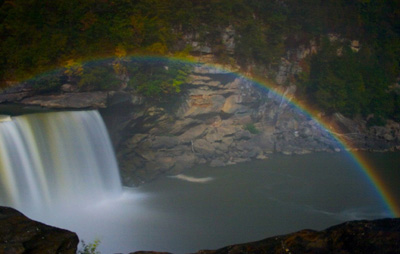
A rainbow is caused by the Sun shining on moisture droplets, most commonly in a post-rain atmosphere. A moon bow is much rarer, only seen at night when the moon is low and full to almost full. One popular place to see moon bows is at Cumberland Falls in Kentucky, as pictured above.
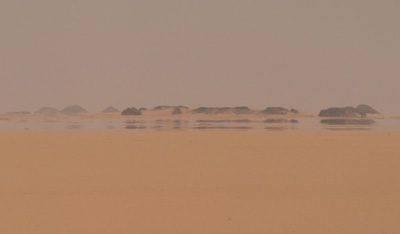
Mirages occur when light is refracted to produce an image of an object or the sky where it is not. It is most commonly seen on hot surfaces, such as the pavement or a desert.
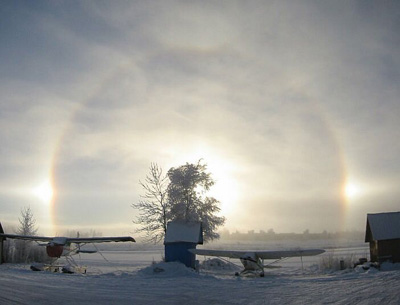
Like rainbows, haloes are formed around the Sun due to moisture (in this case ice crystals) being refracted from the Sun’s rays in the upper atmosphere. Sometimes two or more areas of the circle or arcs surrounding the Sun will be brighter, forming what are called Sun Dogs. Haloes can also form around the Moon, and occasionally around the brighter stars and planets like Venus.

The belt of Venus is a phenomenon that occurs during dusty evenings when a band of pinkish or brownish sky will appear between the sky and the horizon.
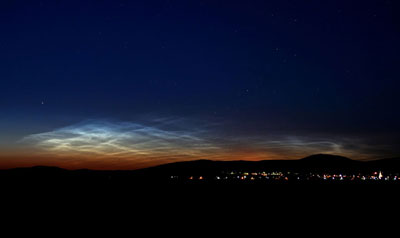
Noctilucent clouds are atmospherically high clouds that refract light at dusk when the Sun has already set, illuminating the sky with no seeming light source.
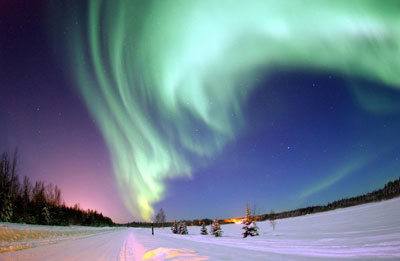
Also known in the southern hemisphere as the Aurora Australis, the Aurora Borealis are charged particles from the Sun that have reached the Earth’s upper atmosphere and become excited. They are more typically seen closer to the poles and during the equinoxes of the year. [Photo taken by Senior Airman Joshua Strang. Large scale public domain copy here.]

Due to different atmospheric issues, the moon will occasionally appear tinged with a color, such as blue, orange, or red. Excess smoke, dust, and eclipses can cause the moon to change color.
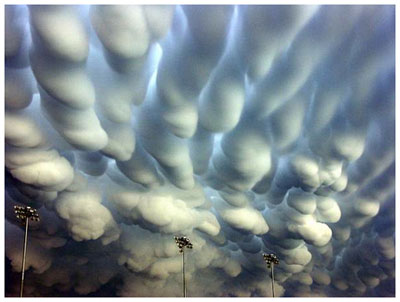
These odd-shaped clouds are often associated with a storm front, especially one involving a thunderstorm. It’s not completely understood how they form. [Image copyright Jorn Olsen, available for purchase here.]
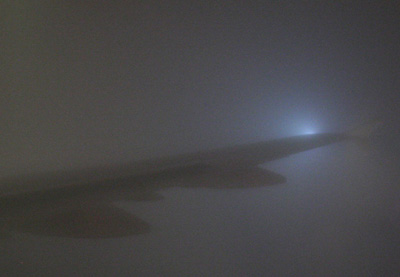
This weather phenomenon is luminous plasma that appears like fire on objects, such as the masts of ships or lightning rods, in an area that is electrically charged during a thunderstorm. This occurrence was named the after St Elmo, the patron saint of sailors.

A fire whirl is either a tornado spinning too close to a forest fire or a whirl created from too much heat in the area.
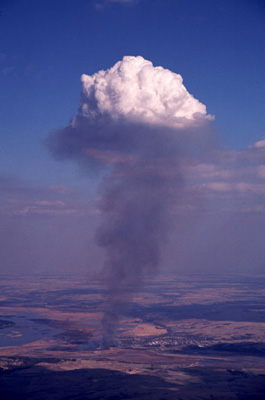
Another heat related phenomenon, pyrocumulus clouds form from the fast and intense heating of an area to create convecture, which in turn creates a cumulous cloud. Volcanoes, forest fires, and nuclear explosion (in the form of a mushroom cloud) are all prime causes of pyrocumulus clouds.
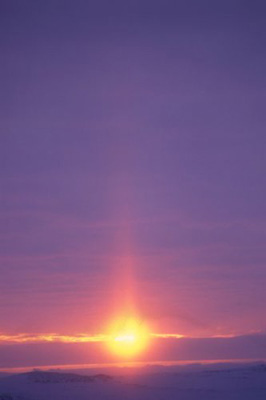
Sun Pillars occur when the setting sun reflects off high, icy clouds at different layers. It creates a pillar of light that reaches high into the sky. It is also possible to see moon pillars.

Linked closely to haloes, diamond dust is a fog made of frozen droplets.
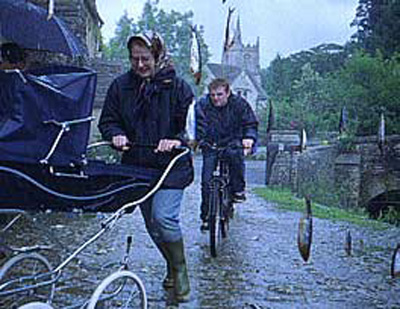
Rare and yet real, cases exist of rains of animals instead of water. This has occurred occasionally throughout history, from the Biblical times up to recent history. Meteorologists are still unsure of the cause.
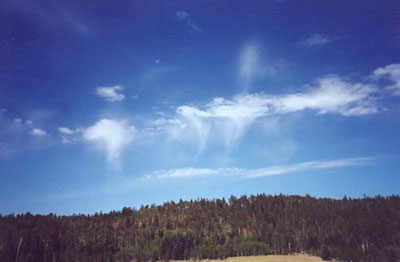
Virga is when ice crystals in clouds fall, but evaporate before hitting the ground. They appear as trails from clouds reaching for the surface, sometimes giving the cloud a jellyfish-like appearance.
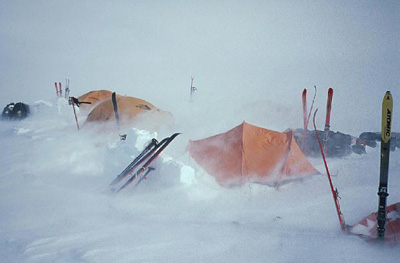
These are winds that carry dense air from a higher elevation to a lower elevation due to gravity. They are known locally as the Santa Ana (southern California), the Mistral (Mediterranean), the Bora (the Adriatic Sea), Oroshi (Japan), Pitaraq (Greenland), and the Williwaw (Tierra del Fuego). The Williwaw and winds traveling over the Antarctic are particularly hazardous, blowing over 100 knots at times.
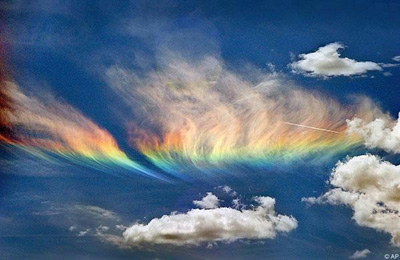
A fire rainbow is an extremely rare phenomenon that occurs only when the sun is high allowing its light to pass through high-altitude cirrus clouds with a high content of ice crystals.
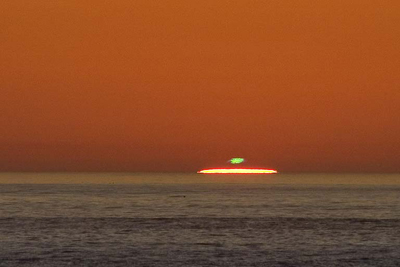
Also known as the Green Flash. This occurs very briefly before total sunset and after sunrise. It appears as a green flash above the sun that lasts very briefly, generally only a few moments. It is caused by refraction of light in the atmosphere.
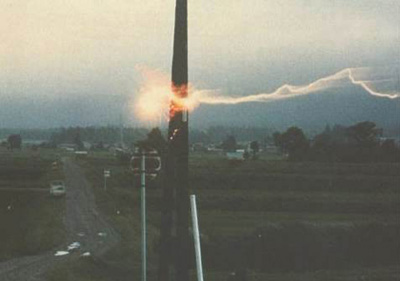
This is a very rare phenomenon that involves ball-shaped lightning that moves much slower than normal lightning. It has been reported to be as large as eight feet in diameter and can cause great damage. There are reports of ball lightning destroying whole buildings.
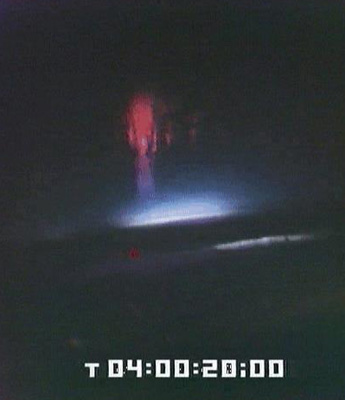
All refer to phenomena that occur in the upper atmosphere in the regions around thunderstorms. They appear as cones, glows and discharges. They were only discovered last century, because of their placement and their very brief life-span (they last less than a second).
Contributor: Cedestra
.
April 19, 2008
20 Amazing And Unusual Weather Phenomena
by cedestra
The science of weather is a fascinating one; but even more so are the flukes and irregularities that can occur within our world. This is a list of 20 of the most amazing and unusual of those anomalies.
20
Moon bows

A rainbow is caused by the Sun shining on moisture droplets, most commonly in a post-rain atmosphere. A moon bow is much rarer, only seen at night when the moon is low and full to almost full. One popular place to see moon bows is at Cumberland Falls in Kentucky, as pictured above.
19
Mirages

Mirages occur when light is refracted to produce an image of an object or the sky where it is not. It is most commonly seen on hot surfaces, such as the pavement or a desert.
18
Haloes

Like rainbows, haloes are formed around the Sun due to moisture (in this case ice crystals) being refracted from the Sun’s rays in the upper atmosphere. Sometimes two or more areas of the circle or arcs surrounding the Sun will be brighter, forming what are called Sun Dogs. Haloes can also form around the Moon, and occasionally around the brighter stars and planets like Venus.
17
Belt of Venus

The belt of Venus is a phenomenon that occurs during dusty evenings when a band of pinkish or brownish sky will appear between the sky and the horizon.
16
Noctilucent Clouds

Noctilucent clouds are atmospherically high clouds that refract light at dusk when the Sun has already set, illuminating the sky with no seeming light source.
15
Aurora Borealis

Also known in the southern hemisphere as the Aurora Australis, the Aurora Borealis are charged particles from the Sun that have reached the Earth’s upper atmosphere and become excited. They are more typically seen closer to the poles and during the equinoxes of the year. [Photo taken by Senior Airman Joshua Strang. Large scale public domain copy here.]
14
Colored Moons

Due to different atmospheric issues, the moon will occasionally appear tinged with a color, such as blue, orange, or red. Excess smoke, dust, and eclipses can cause the moon to change color.
13
Mammatus Clouds

These odd-shaped clouds are often associated with a storm front, especially one involving a thunderstorm. It’s not completely understood how they form. [Image copyright Jorn Olsen, available for purchase here.]
12
St Elmo’s Fire

This weather phenomenon is luminous plasma that appears like fire on objects, such as the masts of ships or lightning rods, in an area that is electrically charged during a thunderstorm. This occurrence was named the after St Elmo, the patron saint of sailors.
11
Fire whirls

A fire whirl is either a tornado spinning too close to a forest fire or a whirl created from too much heat in the area.
10
Pyrocumulus Clouds

Another heat related phenomenon, pyrocumulus clouds form from the fast and intense heating of an area to create convecture, which in turn creates a cumulous cloud. Volcanoes, forest fires, and nuclear explosion (in the form of a mushroom cloud) are all prime causes of pyrocumulus clouds.
9
Sun Pillars

Sun Pillars occur when the setting sun reflects off high, icy clouds at different layers. It creates a pillar of light that reaches high into the sky. It is also possible to see moon pillars.
8
Diamond Dust

Linked closely to haloes, diamond dust is a fog made of frozen droplets.
7
Non-aqueous Rain

Rare and yet real, cases exist of rains of animals instead of water. This has occurred occasionally throughout history, from the Biblical times up to recent history. Meteorologists are still unsure of the cause.
6
Virga

Virga is when ice crystals in clouds fall, but evaporate before hitting the ground. They appear as trails from clouds reaching for the surface, sometimes giving the cloud a jellyfish-like appearance.
5
Katabatic Winds

These are winds that carry dense air from a higher elevation to a lower elevation due to gravity. They are known locally as the Santa Ana (southern California), the Mistral (Mediterranean), the Bora (the Adriatic Sea), Oroshi (Japan), Pitaraq (Greenland), and the Williwaw (Tierra del Fuego). The Williwaw and winds traveling over the Antarctic are particularly hazardous, blowing over 100 knots at times.
4
Fire Rainbow

A fire rainbow is an extremely rare phenomenon that occurs only when the sun is high allowing its light to pass through high-altitude cirrus clouds with a high content of ice crystals.
3
Green Ray

Also known as the Green Flash. This occurs very briefly before total sunset and after sunrise. It appears as a green flash above the sun that lasts very briefly, generally only a few moments. It is caused by refraction of light in the atmosphere.
2
Ball Lightning

This is a very rare phenomenon that involves ball-shaped lightning that moves much slower than normal lightning. It has been reported to be as large as eight feet in diameter and can cause great damage. There are reports of ball lightning destroying whole buildings.
1
Sprites, Jets, and Elves
All refer to phenomena that occur in the upper atmosphere in the regions around thunderstorms. They appear as cones, glows and discharges. They were only discovered last century, because of their placement and their very brief life-span (they last less than a second).
Contributor: Cedestra
.
Friday, April 8, 2011
Thank you for being you!
|
Labels:
Love,
Poem,
Relationship,
Women
Saturday, April 2, 2011
Touching love story unfortunately without happy ending
from www.virtualfunzone.com/
Katie Kirkpatrick, 21, held off cancer to celebrate the happiest day of her life. Katie had chased cancer, once only to have it return-to clog her lungs and grab hold of her heart. Breathing was difficult now, she had to use oxygen. The pain in her back was so intense it broke through the morphine that was supposed to act as a shield. Her organs were shutting down but it would not stop her from marrying Nick Godwin, 23, who was in love with Katie since 11th grade.


Nick Godwin, 23, left, takes a moment of rest while his bride Katie Kirkpatrick, right, gets an intravenous procedure to reduce the amount of fluids her body is retaining at McLaren Regional Medical Center in Flint on January 12, 2005. Nick Godwin who works night shift as a Lapeer County Sheriff’s deputy took Katie to the medical center after a night’s work, three days before their wedding.

Katie Kirkpatrick, 21, puts on some hearings a few minutes before walking down the aisle to marry Nick Godwin, 23, who she had known since 11th grade, at Church of Christ in Hazel Park on Saturday January 15, 2005.
Dave Kirkpatrick gives the thumbs up to his new son in law while admiring the couple with his wife Niki Kirkpatrick, right, after Nick and Katie got married at Church of Christ in Hazel Park on Saturday January 15, 2005.
Katie Kirkpatrick Godwin, right, gets serenaded by her new husband Nick Godwin, and his best men during the wedding party on the dance floor at Boulder Point Golf Club and Banquet Center in Oxford, MI, on Saturday January 15, 2005.
Katie Kirkpatrick, 21, and Nick Godwin, 23, cuddle up for a moment while waiting for the wedding photographer to get ready after getting married at Church of Christ in Hazel Park on Saturday January 15, 2005.
Katie Kirkpatrick Godwin, center, rests for a few moments during her wedding party at Boulder Point Golf Club and Banquet Center in Oxford, MI, on Saturday January 15, 2005. Katie was exhausted. Her face looked as white as her gown.

Katie Kirkpatrick, 21, held off cancer to celebrate the happiest day of her life. Katie had chased cancer, once only to have it return-to clog her lungs and grab hold of her heart. Breathing was difficult now, she had to use oxygen. The pain in her back was so intense it broke through the morphine that was supposed to act as a shield. Her organs were shutting down but it would not stop her from marrying Nick Godwin, 23, who was in love with Katie since 11th grade.


Nick Godwin, 23, left, takes a moment of rest while his bride Katie Kirkpatrick, right, gets an intravenous procedure to reduce the amount of fluids her body is retaining at McLaren Regional Medical Center in Flint on January 12, 2005. Nick Godwin who works night shift as a Lapeer County Sheriff’s deputy took Katie to the medical center after a night’s work, three days before their wedding.


Katie Kirkpatrick, 21, puts on some hearings a few minutes before walking down the aisle to marry Nick Godwin, 23, who she had known since 11th grade, at Church of Christ in Hazel Park on Saturday January 15, 2005.

Dave Kirkpatrick gives the thumbs up to his new son in law while admiring the couple with his wife Niki Kirkpatrick, right, after Nick and Katie got married at Church of Christ in Hazel Park on Saturday January 15, 2005.

Katie Kirkpatrick Godwin, right, gets serenaded by her new husband Nick Godwin, and his best men during the wedding party on the dance floor at Boulder Point Golf Club and Banquet Center in Oxford, MI, on Saturday January 15, 2005.

Katie Kirkpatrick, 21, and Nick Godwin, 23, cuddle up for a moment while waiting for the wedding photographer to get ready after getting married at Church of Christ in Hazel Park on Saturday January 15, 2005.

Katie Kirkpatrick Godwin, center, rests for a few moments during her wedding party at Boulder Point Golf Club and Banquet Center in Oxford, MI, on Saturday January 15, 2005. Katie was exhausted. Her face looked as white as her gown.
Five days later, Katie died. She did not let sickness stop her from living, take away the hope or faith that made her believe she had a future. She had a lovely wedding and she had love and she gave love and love doesn’ t die. And that is how Katie beat cancer.


Subscribe to:
Posts (Atom)






















